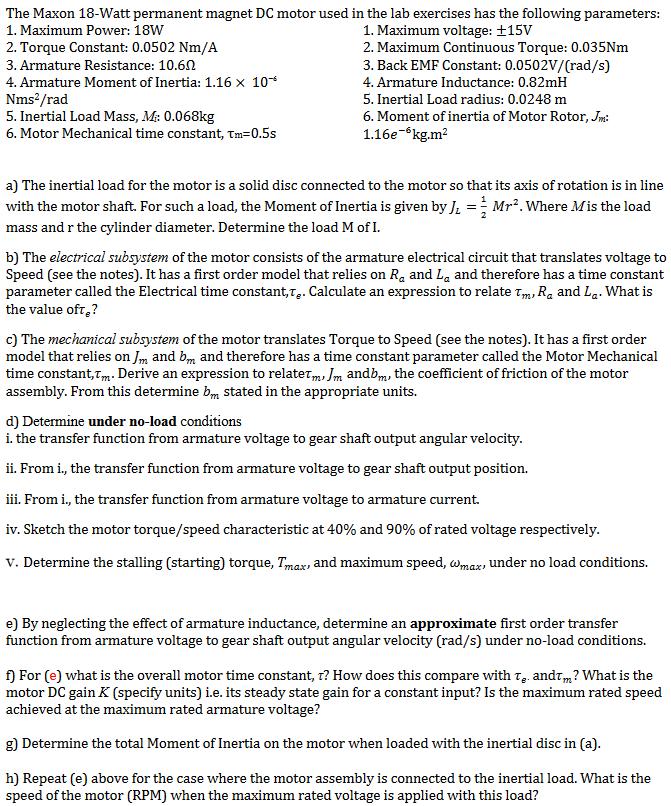Answered step by step
Verified Expert Solution
Question
1 Approved Answer
The Maxon 18-Watt permanent magnet DC motor used in the lab exercises has the following parameters: 1. Maximum Power: 18W 1. Maximum voltage: +15V

The Maxon 18-Watt permanent magnet DC motor used in the lab exercises has the following parameters: 1. Maximum Power: 18W 1. Maximum voltage: +15V 2. Torque Constant: 0.0502 Nm/A 2. Maximum Continuous Torque: 0.035Nm 3. Back EMF Constant: 0.0502V/(rad/s) 3. Armature Resistance: 10.60 4. Armature Inductance: 0.82mH 4. Armature Moment of Inertia: 1.16 x 10** Nms/rad 5. Inertial Load radius: 0.0248 m 5. Inertial Load Mass, M;: 0.068kg 6. Moment of inertia of Motor Rotor, Jm: 1.16e-6kg.m 6.Motor Mechanical time constant, Tm=0.5s a) The inertial load for the motor is a solid disc connected to the motor so that its axis of rotation is in line with the motor shaft. For such a load, the Moment of Inertia is given by J Mr. Where Mis the load mass and r the cylinder diameter. Determine the load Mof I. b) The electrical subsystem of the motor consists of the armature electrical circuit that translates voltage to Speed (see the notes). It has a first order model that relies on Ra and La and therefore has a time constant parameter called the Electrical time constant, T. Calculate an expression to relate Tm, Ra and La. What is the value oft? c) The mechanical subsystem of the motor translates Torque to Speed (see the notes). It has a first order model that relies on Jm and bm and therefore has a time constant parameter called the Motor Mechanical time constant, Tm. Derive an expression to relaterm, Jm andbm, the coefficient of friction of the motor assembly. From this determine bm stated in the appropriate units. d) Determine under no-load conditions i. the transfer function from armature voltage to gear shaft output angular velocity. ii. From i., the transfer function from armature voltage to gear shaft output position. iii. From i., the transfer function from armature voltage to armature current. iv. Sketch the motor torque/speed characteristic at 40% and 90% of rated voltage respectively. v. Determine the stalling (starting) torque, Tmax, and maximum speed, max, under no load conditions. e) By neglecting the effect of armature inductance, determine an approximate first order transfer function from armature voltage to gear shaft output angular velocity (rad/s) under no-load conditions. f) For (e) what is the overall motor time constant, t? How does this compare with T. andm? What is the motor DC gain K (specify units) i.e. its steady state gain for a constant input? Is the maximum rated speed achieved at the maximum rated armature voltage? g) Determine the total Moment of Inertia on the motor when loaded with the inertial disc in (a). h) Repeat (e) above for the case where the motor assembly is connected to the inertial load. What is the speed of the motor (RPM) when the maximum rated voltage is applied with this load?
Step by Step Solution
★★★★★
3.35 Rating (164 Votes )
There are 3 Steps involved in it
Step: 1
a The Moment of Inertia J of the solid disc connected to the motor is calculated using the formula J 12 M r2 where M is the load mass and r is the cyl...
Get Instant Access to Expert-Tailored Solutions
See step-by-step solutions with expert insights and AI powered tools for academic success
Step: 2

Step: 3

Ace Your Homework with AI
Get the answers you need in no time with our AI-driven, step-by-step assistance
Get Started


